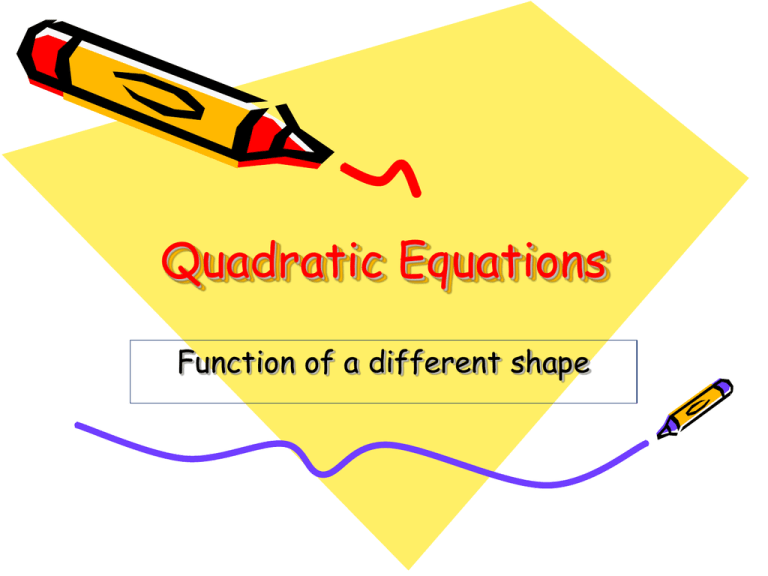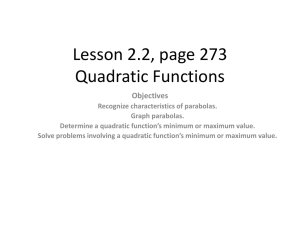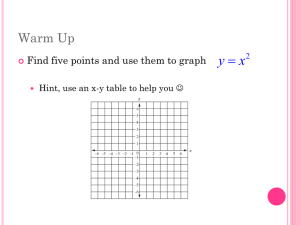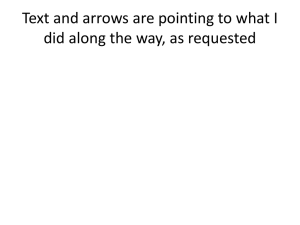Quadratic Equations
advertisement

Quadratic Equations Function of a different shape There are many uses of parabolas in real-world applications. Graphs of Quadratic Functions Plotting quadratic curves If you remember a relation is a correspondence between two sets of numbers called the domain and range. If each member of the domain is assigned exactly one member of the range, then the relation is a function. A function can be represented as a list or a table of ordered pairs, a graph in the coordinate plane, or an equation in two variables. If you notice, the right side of the equation y = 3x + 2 is a polynomial. Can you classify the polynomial by degree? A function of this form (y = mx + b) is called a linear function. Note the graph is a straight line. Y = 3x + 2 Now consider the equation y = x2 + 6x – 1 Classify the polynomial on the right. A function defined by an equation of this form y = ax2 + bx + c is called a quadratic function. Now we are going to investigate this form. Let’s try a little experiment with your graphing calculator. Graph the equation y = x2 on the coordinate plane. Now graph y = 3x2 on the same coordinate plane. How are the graphs the same? How are they different? Can you predict how the graph of y = ¼x2 will be similar or different? HINT: Graph y = x2 first, next graph y = 3x2 to see what differences or similarities are present. Now graph y = ¼x2 to see how the shape of the graph changes. Type in y = x2 on the graphing calculator. Graph of y = x2 Now graph y = 3x2 Type in y = 3x2 on the graphing calculator. Graph of y = x2 and y = 3x2 on the same graph. How are the graphs the same? How are they different? Can you predict what y = ¼x2 looks? Type in y = x2, y = 3x2, and y = ¼x2. What differences do you notice in the new graph y = ¼x2. Graphs of y = x2, y = 3x2, and y = ¼x2. These functions (equations) are quadratic functions. Standard Form of a Quadratic Function A quadratic function - is a function that can be written in the form y = ax2 + bx + c, where a ≠ 0. This form is called the standard form of a quadratic function. Ex: y = 5x2 y = x2 + 7 y = x2 –x -3 The variable in a quadratic function is squared (x2), so the graph forms a curved line called a parabola. All quadratic functions have the same shape. The graph of y = x2 forms this U-shaped graph called a parabola. Axis of symmetry You can fold a parabola so that the two sides match exactly. This property is called symmetry. The fold or line that divides the parabola into two matching halves is called the axis of symmetry. Minimum point The highest or lowest point of a parabola is its vertex, which is on the axis of symmetry. If a > 0 in (a positive number) y = ax2 + bx + c Maximum point the parabola opens upward. The vertex is the minimum point or lowest point of the graph. If a < 0 in (a negative number) y = -ax2 + bx + c the parabola opens downward. The vertex is the maximum point or highest point of the graph Identifying a Vertex Identify the vertex of each graph. Tell whether it is a minimum or maximum. On the left is the graph of a parabola. Below are examples of equations of parabolas. y = x2 x = y2 y = x2 + 2x + 3 Graphing y = ax2 You can use the fact that a parabola is symmetric to graph it quickly. Remember our original experiment when we graphed y = x2 and y = 3x2 First, find the coordinates of the vertex and several points on either side of the vertex. Then reflect the points across the axis of symmetry. For functions of the form of y = ax2, the vertex is at the origin. Make a table for the function y = x2 using x = 0, 1, 2, and 4. Try this Make a table for y = x2 using x = 0, 1, 2, 4. Graph the points on the graph then reflect the x-values to the other side of the graph. Try another Make a table of values and graph the quadratic function f(x) = -2x2 using x = 0, 1, 2, 4 Remember these are functions so we also use the function notation f(x) Graphing y = ax2 + c Graphing y = ax2 + c (y = 2x + 4) The value of c, the constant term in a quadratic function, translates the graph up or down. 2 Make a table and graph y = 2x2 Make a table and graph Y = 2x2 + 3 Try it Graph y = x2 and y = x2 - 4 This time let’s use the same graph for both. Real world application height (feet) The graph shows at 0 seconds the object is at 50 feet, after one second the object has already fallen to 34 feet, and at 1½ seconds the object has hit the ground seconds Seagull drops a clam to break the shell so it can eat it. The gull drops the clam from 50 feet in the air. Real World Problem You can model the height of an object moving under the influence of gravity using a quadratic function. As an object falls, its speed continues to increase. You can find the height of a falling object using the function h = -16t2 + c. The height h is in feet, the time t is in seconds, and the initial height of the object c is in feet. Try one Suppose a squirrel is in a tree 60 feet off the ground. She drops an acorn. The function h = -16t2 + 60 gives the height h of the acorn in feet after t seconds. Make a table and graph this function. Graph each function • y = -x2 • y = 2x2 • y = 3x2 – 6 • y = -½x2 + 3 Match the graph Can you match these graphs with their functions? f(x) = x2 + 4 f(x) = -x2 + 2 Graph of a Quadratic Function f(x) = ax2 + bx + c So far we have investigated the graphs of y = ax2 and y = ax2 + c. In these functions c has always been 0, which means the axis of symmetry has always been the y-axis. In the quadratic function y = ax2 + bx + c, the value of b affects the position of the axis of symmetry, moving it left or right. In the next slide we are going to consider functions in the form of y = ax2 + bx + c Notice that both graphs have the same y-intercept. This is because in both equations c = 0 y = 2x2 + 2x Y = 2x2 + 4x The axis of symmetry changes with each change in the b value. Since the axis of symmetry is related to the change in the b value, the equation of the axis of symmetry is related to the ratio b/a x = -b/2a Let’s try one! To find the y-value, first substitute a and b into the equation x = -b/2a and solve to find x. Then substitute x back into the original equation to determine y. Find the coordinates of the vertex and an equation for the axis of symmetry. Then graph the function. y = x2 – 4x + 3 a = 1, b = -4, and c = 3 x = -b/2a x = -(-4)/2(1) = 4/2 = 2 axis of symmetry: x = 2 If x = 2, then y = x2 -4x + 3 = y = 22 - 4(2) + 3 = -1 Use the equation for the axis of symmetry. x = -b/2a Substitute the x-value into the original equation and solve for y. the vertex is (2, -1) Now make a table. Since the vertex of the axis of symmetry is (2, -1) and we know the parabola turns upward (a > 0), we can use values on both sides of (2, -1). X Y -1 8 0 3 1 0 2 -1 3 0 4 3 5 8 Now graph your points and draw a curved line. Try this one. y= -x2 +4 a = ,b = c = Find x = -b/2a x = x y Substitute the xvalue into the equation y = -x2 + 4 Now use your vertex as the middle of your table. Solve problems Graph each function. Label the axis of symmetry and the vertex. 1) y = x2 + 4x + 3 2) y = 2x2 – 6x 3) y =x2 + 4x – 4 4) y = 2x2 + 3x + 1 Real world problem In professional fireworks displays, aerial fireworks carry “stars” upward, ignite them, and project them into the air. The equation h = -16t2 + 72t + 520 gives the star’s height h in feet at time t in seconds. Since the coefficient of t2 is negative, the curve opens downward, and the vertex is the maximum point. Find the t-coordinate of the vertex x = -b/2a = -72/2(-16) = 2.25 After 2.25 seconds, the star will be at its greatest height. Find the h-coordinate of the vertex. h = -16(2.25)2 + 72(2.25) + 520 = 601 The maximum height of the star will be 601 feet. TRY THIS The shape of the Gateway Arch in St. Louis, Missouri, is a catenary curve that resembles a parabola. The equation h = -0.00635x2 + 4.0005x – 0.07875 represents the parabola, where h is the height in feet and x is the distance from one base in feet. What is the equation of the axis of symmetry? What is the maximum height of the arch? Using the Quadratic Formula Solving any quadratic equations. In our earlier lesson, you solved quadratic equations by factoring. Another method, which will solve any quadratic equation, is to use the quadratic formula as seen left. Here values of a, b, and c are substituted into the formula to determine x. Be sure to write a quadratic equation in standard form before using the quadratic formula. Solve: x2 + 6 = 5x x2 -5x + 6 = 0 Solve: x2 + 2 = -3x VERTICAL MOTION FORMULA h = -16t2 + vt + c The initial upward velocity is v, and the starting height is c You can use the quadratic formula to solve real-world problems. Suppose a football player kicks a ball and gives it an initial velocity of 47ft/s. The starting height of the football is 3 ft. If no one catches the football how long will it be in the air? Using the vertical motion formula and the information given, the formula h = -16t2 + vt + c represents this illustration. You must decide whether a solution makes sense in the real-world situation. For example, a negative value for time is not a reasonable solution. Use the vertical motion formula h = -16t2 + vt + c 1) A child tosses a ball upward with a starting velocity of 10 ft/s from a height of 3 ft. a. Substitute the values into the vertical motion formula. Let h = 0 b. Solve. If it is not caught, how long will the ball be in the air? Round to the nearest tenth of a second. 2) A soccer ball is kicked with a starting velocity of 50 ft/s from a starting height of 3.5 ft. a. Substitute the values into the vertical motion formula. Let h = 0 b. Solve. If no one touches the ball, how long will the ball be in the air? TRY THIS The function below models the United States population P in millions since 1900, where t is the number of years after 1900. P = 0.0089t2 + 1.1149t + 78.4491 a. Use the function to estimate the US population the year I graduated from high school. b. Estimate the US population in 2025. c. Estimate the US population in 2050. Try Another A carnival game involves striking a lever that forces a weight up a tube to strike a bell which will win you a prize. If the weight reaches 20 feet and strikes the bell, you win. The equation h = -16t2 + 32t + 3 gives the height h of the weight if the initial velocity v is 32 ft/s. Find the maximum height of the weight. Will the contestant win a prize? One More The Sky Concert in Peoria, Illinois, is a 4th of July fireworks display set to music. If a rocket (firework) is launched with an initial velocity of 39.2 m/s at a height of 1.6 m above the ground, the equation, h = -4.9t2 + 39.2t + 1.6 represents the rockets height h in meters after t seconds. The rocket will explode at approximately the highest point. At what height will the rocket explode? Review If a quadratic equation is written in the form ax2 + bx + c = 0, the solutions can be found using the quadratic formula. In the quadratic equation, the expression under the radical sign, b2 – 4ac, is called the discriminant. 1) If b2 – 4ac is a negative number, the square root cannot be found as a real number. There are no real-number solutions. 2) If b2 – 4ac equals 0, there is only one solution of the equation. 3) If b2 – 4ac is a positive number, there are two solutions of the equation. The graph of the quadratic intersects the x-axis twice.









